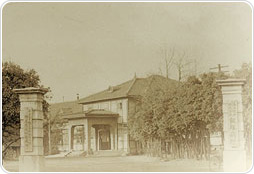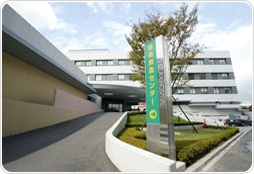History
“To bring together skilled physicians, and provide
the best in medical treatment and
provision of medicine for the people of the region”‒ from establishment to the 1980s
【From establishment, start of medical treatment and opening to general public】
 Even at the beginning of the 20th century, there was no public medical facility in the Chikuho region and those who needed special care had to go to a university hospital in Fukuoka City. With limited public awareness of hygiene and a crude system for epidemic control, the region suffered serious losses every time a dysentery or
cholera epidemic swept the area. Also, this was at the time of the rise of modern industries, when the increase in tuberculosis patients became a social issue.
Even at the beginning of the 20th century, there was no public medical facility in the Chikuho region and those who needed special care had to go to a university hospital in Fukuoka City. With limited public awareness of hygiene and a crude system for epidemic control, the region suffered serious losses every time a dysentery or
cholera epidemic swept the area. Also, this was at the time of the rise of modern industries, when the increase in tuberculosis patients became a social issue.
Faced with these challenges of the time, Takichi Aso, the great-great grandfather of the current president,
aspired to build an excellent hospital in the Chikuho region and contribute to regional healthcare and the welfare of the residents. Around the same time, the Kaho district assembly passed a resolution to build a district hospital, although it was unable to deal with the issues of securing funding for the high construction costs and medical professionals. Seeing the chance to realize his aspiration, Takichi proposed to the head of the district and the assembly that he would build the hospital himself instead of the district. Naturally, the assembly accepted this proposal unanimously. This was in September 1908.
In early spring 1910, the hospital was completed. Unexpectedly however, its opening was opposed by a movement that was l ed by the district’s medical association. As a result, the doors of the beautifully finished hospital remained closed for about 10 years. The hospital finally started operation on August 9, 1918, after the incorporation in May of Aso Shoten, Takichi’ s coal business which was once run privately.
The hospital changed its name in September 1920 to Aso Iizuka Hospital and finally started treating the general public. Since then, Aso Iizuka Hospital has remained true to the spirit of Takichi Aso to“bring together skilled physicians, and provide the best in medical treatment and provision of medicine for the people of the region” (from“ Aso Takichi Den” (The life of Takichi Aso). We have spared no effort in improving regional healthcare and grown as the citizens’ hospital in the Chikuho region surrounding Iizuka City.
From the 1950s to 1980s, the hospital expanded and its functions strengthened with the addition of new departments as well as beds through the construction of the South, Central and East Wings.
Three epoch-making events in the hospital’s reformation period (1980s to 1998)
【Opening of Emergency and Critical Care Center, start of residency training for physicians and introduction of TQM】
From the 1980s, new functions were added one after another, which later became synonymous with the current Aso Iizuka Hospital. The first epoch-making event for the hospital was the opening of the Emergency and Critical Care Center in April 1982. With the enhanced ICU and surgical facilities and new Cardiology and Neurosurgery Departments, it had taken its first step as a comprehensive medical center in the Chikuho region.
The second epoch-making event was its designation as a residency training hospital in April 1989. We started offering postgraduate training at the same time, with excellent physicians dedicated to training others, so that doctors-in-training could acquire a wide-range of clinical care abilities. Since October 1993, we have sent new doctors for training at the Georgetown University Medical Center (GTU). That was possible thanks to the ties we had forged with them. Also, Aso Iizuka Hospital, in its capacity as a training and education facility, has been accredited as an educational hospital by the Japanese Society of Internal Medicine and as a diplomate training facility by the Japan Primary Care Association.
The third epoch-making event came in July 1992 when we launched our TQM (Total Quality Management) activities. The activities are implemented under the theme of better quality and services in medicine and management. Our achievements have been compiled in two books. Aso Iizuka Hospital was evaluated by the Japan Council for Quality Health Care in February 1998 and accredited as a hospital which meets criteria predetermined by the Council. These activities to improve the hospital’s management created more interest in the quality of healthcare, and consequently led to the adoption of the critical path method, EBM(evidence-based medicine) and benchmarks.
Further evolution and development (since 1999)
【promotion of glocal (global & local) medical and improvement a ctivities】
 In 2004, the Emergency and Critical Care Center was moved from the East Wing to the newly-completed High Care Wing. The activity level of the Emergency and Critical Care Center has gone up s ince, to 45,000-50,000 emergency patients annually including about 7,500 emergency transport cases. We started the operation of a“ doctor car” in 2012 so that treatment can begin on-site. Under the slogan of “making the Chikuho region t he area with the most advanced emergency care in Japan,” our emergency medical care keeps evolving. Designated as a regional medical care support hospital in 2005, we have worked with those in regional medical facilities to improve the medical environment in the Chikuho region in the field of emergency medical care and beyond. Other activities that address and support regional medical care with local residents include the establishment of the Aso Iizuka Hospital Medical Treatment Conference (the present day Aso Iizuka Hospital Medical Treatment Community Committee) in 2005, and the Community Healthcare Supporter program in 2010.
In 2004, the Emergency and Critical Care Center was moved from the East Wing to the newly-completed High Care Wing. The activity level of the Emergency and Critical Care Center has gone up s ince, to 45,000-50,000 emergency patients annually including about 7,500 emergency transport cases. We started the operation of a“ doctor car” in 2012 so that treatment can begin on-site. Under the slogan of “making the Chikuho region t he area with the most advanced emergency care in Japan,” our emergency medical care keeps evolving. Designated as a regional medical care support hospital in 2005, we have worked with those in regional medical facilities to improve the medical environment in the Chikuho region in the field of emergency medical care and beyond. Other activities that address and support regional medical care with local residents include the establishment of the Aso Iizuka Hospital Medical Treatment Conference (the present day Aso Iizuka Hospital Medical Treatment Community Committee) in 2005, and the Community Healthcare Supporter program in 2010.
As for training and education, we concluded a formal agreement on training and education in 2009 with the University of Pittsburgh Medical Center, with which we had had prior exchange. We invite an instructor from Pittsburgh every month to prepare the curriculum for training for young physicians as well as that for junior and senior residency training. Our unique training curriculum is created and operated based on the ACGME’s (Accreditation Council for Graduate Medical Education) 6 Competencies. Aso Iizuka Hospital is renowned for its training environment thanks to its record of serving as a training hospital for many years, a system of training given by those who have just finished the training, and “the spirit of sharing”.The number of applicants for training exceeds the full quota every year. The interim results of the 2011 Japan Residency Matching Program showed that Aso Iizuka Hospital was listed as the first choice by the fifth largest number of students amongst all hospitals (excluding university hospitals) in Japan.
Aso Iizuka Hospital led the medical industry in the adoption of TQM in 1992. Our TQM annual conference, which provides an opportunity to show the results of our TQM activities, is attended by more than 500 observers from medical facilities nationwide. In 2001, we were granted ISO14001 certification, making us the first such medical institution in Kyushu and ninth in Japan. In 2008, we gained ISO9001 certification for the entire hospital, which was the largest scale to be covered by the certification in Japan. The 2010 establishment of the Kaizen Promotion Office prompted the regular dispatch of staff to the Virginia Mason Medical Center and the introduction of lean management. With more improvement methods available, there are many improvement activities underway in the hospital.
Aso Iizuka Hospital is determined to achieve further success as a hospital that provides acute care and education. Towards this goal, we aim to improve treatment results, enhance our medical care functions and their efficiency, and adapt swiftly to changes in the environment surrounding healthcare.
Facts & Figures
| No. of employees |
| |||||||||||||||||||||||||||||||||||||||||||||
|---|---|---|---|---|---|---|---|---|---|---|---|---|---|---|---|---|---|---|---|---|---|---|---|---|---|---|---|---|---|---|---|---|---|---|---|---|---|---|---|---|---|---|---|---|---|---|
| Treatment statistics(2023) |
|
|||||||||||||||||||||||||||||||||||||||||||||
| Departments (43 in total) |
|